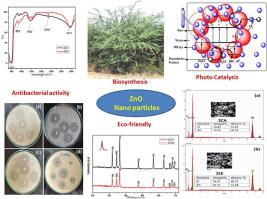Journal of Saudi Chemical Society ( IF 5.8 ) Pub Date : 2020-03-21 , DOI: 10.1016/j.jscs.2020.03.003 S. Sheik Mydeen , R. Raj Kumar , M. Kottaisamy , V.S. Vasantha

|
Rust-induced photocatalytic and antibacterial activities of ZnO nanoparticles derived from Prosopis juliflora leaf extracts by biosynthesis using the hydrothermal method at 170 °C are reported in this study. The characterization has been accomplished by various methods such as XRD, DRS, FT-IR, SEM, TEM, EDAX, and PL spectra. XRD exhibits that ZnO has a hexagonal wurtzite structure with a preferred orientation of 101 planes. The functional groups, which are present in the leaf extracts, are responsible for corresponding peaks in FT-IR spectra. The FESEM images of the synthesized nanoparticles show the morphology sphere like structure. ZnO particle size of 65 nm has been observed from HR-TEM analysis. The elemental composition has a good agreement with the biosynthesized ZnO nanoparticles. The antibacterial activities have been carried out in vitro assays against four different pathogens viz Escherichia coli (E. coli), Rhodococcus rhodochrous (R. rhodochrous), Bacillus subtilis (B. subtilis) and Vibrio cholera (V. Cholera) against a standard (streptomycin sulfate). Furthermore, the Photocatalytic ability of the titled nanoparticles has been experimented from the rust solution with methylene blue and degradation under UV radiation of 99%. The proposed mechanism is based on scavenger studies and it is investigated during the photo degradation of Methylene blue. The catalytic amount and recovery of photocatalyst have also been studied in detail.
中文翻译:

菜豆叶片提取物对ZnO纳米粒子的生物合成:抗菌活性及防锈光催化新方法
本研究报道了水热法在170°C下通过生物合成法从水生胡蜂叶片提取物中得到的ZnO纳米粒子的锈蚀诱导的光催化和抗菌活性。表征已通过多种方法完成,例如XRD,DRS,FT-IR,SEM,TEM,EDAX和PL光谱。XRD显示ZnO具有六方纤锌矿结构,优选取向为101个平面。叶提取物中存在的官能团负责FT-IR光谱中的相应峰。合成的纳米颗粒的FESEM图像显示出形态球形的结构。通过HR-TEM分析观察到ZnO粒径为65 nm。元素组成与生物合成的ZnO纳米颗粒具有良好的一致性。已经进行了抗菌活性针对四种不同病原体的体外测定,分别针对标准品(硫酸链霉素),其中包括四种不同的病原体,即大肠杆菌(E. coli),Rhodococcus rhodochrous(R. rhodochrous),枯草芽孢杆菌(B. subtilis)和霍乱弧菌(V. Cholera)。此外,已经从具有亚甲基蓝的防锈溶液中试验了标题纳米颗粒的光催化能力,并在99%的紫外线辐射下降解了纳米颗粒。所提出的机理基于清除剂研究,并且在亚甲基蓝的光降解过程中进行了研究。还已经详细研究了光催化剂的催化量和回收率。











































 京公网安备 11010802027423号
京公网安备 11010802027423号